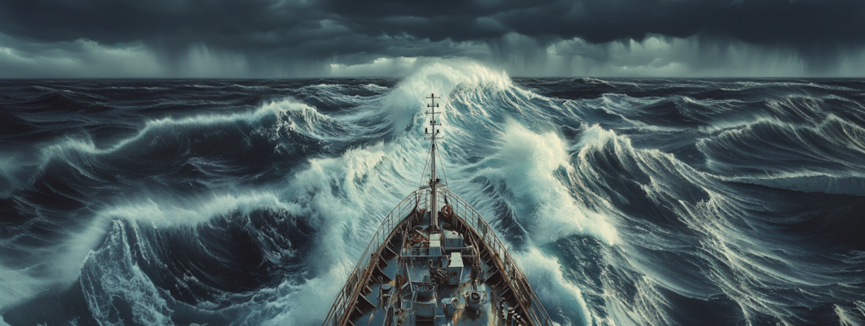If you live on the Gulf Coast, you know the drill. Hurricane season rolls around, weather reports show a storm barreling right toward you, and you board up the windows, check your emergency supplies, and hope for the best (or evacuate, depending on how big the storm is).
But Asheville, North Carolina? That’s a different story.
When Hurricane Helene tore through the Southeast, it didn’t just devastate coastal communities — it pushed hundreds of miles inland, bringing unprecedented flooding to a city nestled in the mountains. A city that’s 300 miles from the coast. A city where “hurricane preparation” wasn’t exactly top of mind for most business owners.
And yet there they were: no running water, no power, businesses shuttered during peak tourism season. All because a coastal hurricane decided to rewrite the rules about where it could go.
It’s a stark reminder that in today’s world, disaster preparedness isn’t just for the usual suspects anymore. The old rules about “safe” locations don’t apply when storms can push hundreds of miles inland, when winter storms can put Texas in a deep freeze, or when wildfires can threaten basically the entire western half of the U.S.
The True Cost of Being Unprepared
Think of it this way: your business is like a ship. When the weather’s good, you’re focused on steering toward your destination — growing revenue, serving customers, building your team, whatever. But what happens when a storm hits?
And I’m not just talking about hurricanes. Remember when the power grid here in Texas went down in 2021? Businesses that thought they were insulated from weather problems other than maybe hail or tornadoes suddenly found themselves dealing with burst pipes, server rooms without power, and employees who couldn’t get online. In a state built for heat waves, we learned the hard way that disasters don’t always look like what we expect.
The businesses that came through that relatively unscathed weren’t the ones with the biggest metaphorical boats or the most expensive equipment. They’re the ones that took the time to:
- Map out their emergency plans
- Train their team
- Install the right safety equipment
- Create backup plans (and backup plans for their backup plans)
- Establish a Business Continuity Plan so everyone is on the same page
Without these preparations, you’re essentially crossing your fingers and hoping for the best. And hope, my friends, is not a strategy.
The Ripple Effect of Disaster
When a natural disaster strikes, it’s not just about the immediate impact — it’s about the ripple effect that follows:
- Your data is gone
- Your team can’t communicate
- Your customers can’t reach you
- Your reputation takes a hit
- Your revenue drops to zero, at least temporarily
And just like we saw in Texas, when critical infrastructure fails, it doesn’t matter how well-prepared you think you are — unless you’ve actually done the work to be prepared.
Building Your Business’s Life Raft
Remember that business “ship” we were talking about? Well, it’s time to build your life raft. And much like a ship’s life raft, this one needs to be built long before you’re out at sea.
Here’s what that looks like:
1) Your Data is Your Most Valuable Cargo
When the floods hit Western North Carolina, businesses lost everything — computers, servers, phones, you name it. But the ones who had their data backed up in the cloud? They were back up and running as soon as they had power and replacement equipment. During the Texas freeze, businesses with cloud-based systems could keep operating even when their physical locations were inaccessible.
2) Your Crew Needs a Game Plan
It’s not enough to have a plan in your head. Your entire team needs to know:
- Who’s in charge of what
- How to communicate when normal channels are down
- Where to find emergency resources
- What to tell your customers
- How to work remotely when the office isn’t an option
3) Your Infrastructure Needs to Be Battle-Ready
Think of this as reinforcing your ship before the storm hits:
- Strengthening your physical space
- Setting up redundant communication systems
- Creating backup power solutions (something Texas businesses now know all too well)
- Establishing alternate work locations
- Installing proper environmental controls for server rooms
The Leverage Difference
At Leverage Technologies, we’ve seen firsthand what happens when businesses aren’t prepared for disasters. But more importantly, we’ve helped countless Texas organizations build the resilience they need to weather any storm — whether it comes as ice, water, wind, or cyberattacks.
Think of us as your ship’s engineer — we’re here to:
- Design and implement your backup systems
- Create your disaster recovery plan
- Test your business continuity strategies
- Keep your technology infrastructure ship-shape
- Guide you through the recovery process if disaster does strike
Don’t Wait for the Storm Warnings
Here’s the reality: by the time you see the storm coming, it’s usually too late to prepare properly. You don’t start building a boat when you’re already in the water — and you shouldn’t wait for disaster to strike before thinking about how to protect your business.
Ready to make sure your business can weather any storm? Let’s talk about building your disaster preparedness strategy. At Leverage Technologies, we don’t just help you prepare for disasters — we help make sure your business is resilient enough to thrive through them.
Because when it comes to protecting your business, hope isn’t a strategy — but we are.


Dive straight into the feedback!Login below and you can start commenting using your own user instantly